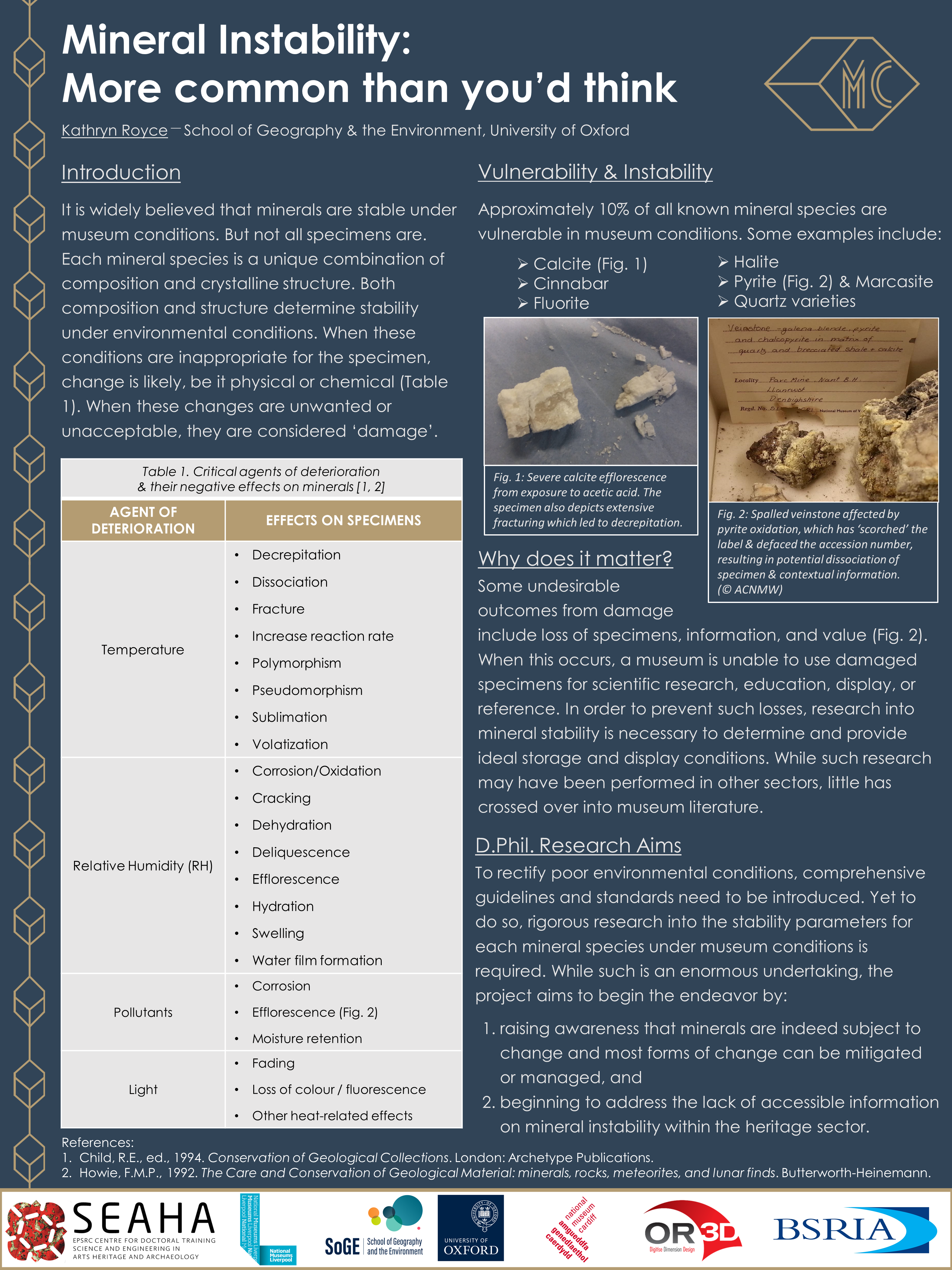About
the Project
This project is part of the Science and Engineering in Arts, Heritage, and Archaeology Centre for Doctoral Training (SEAHA CDT) funded by the Engineering and Physical Sciences Research Council (EPSRC), the Pilgrim Trust, the Barbara Whatmore Charitable Trust, and the National Conservation Service (NCS). It is a collaborative initiative between the University of Oxford, National Museum Wales Cardiff (NMC), National Museums Liverpool (NML), BSRIA Ltd., and OR3D.
The project supervisors are Professor Heather Viles (University of Oxford), Dr. Christian Baars (NML), Dr. Jana Horak (NMC), and Tom Garrigan (BSRIA Ltd.).
Each SEAHA project has partners from academia, heritage, and industry, with each partner providing a supervisor. The project is co-created by these partners to answer specific questions and problems faced by museums and heritage. This particular project stems from a lack of knowledge on the behaviour of geological materials in museum environments.
While there is evidence for these materials being unstable, geological collections have not garnered sufficient attention and research to answer the plethora of questions posed by museum professionals. This research project was proposed as a means of rectifying this lack through establishing an awareness of the materials’ susceptibility and by beginning the detailed, scientific studies required. This will bring the knowledge up to par with that available for other material types found in museums, such as paintings, ceramics, and archaeological finds.
Aims & Scope
The scope of the project has been narrowed from geological materials—which encompasses minerals, rocks, fossils, subfossils, and their associated materials—to just minerals, as they are the building blocks of other geological materials. Even still, this is a massive undertaking, as there is a total of 5,828 currently known mineral species (IMA 2022). However, not all mineral species can persist within the museum environment, due to requiring substantially different temperatures and or pressures to exist. Additionally, many, if not most, mineral species are not represented in museum collections. Over half of known mineral species are considered rare (i.e., are documented to occur in five or fewer localities), and many newly identified species only form at the micro- or nano-scale and were discovered during experiments utilising high-resolution microscopy and spectroscopy (Hazen & Ausubel 2016, Lee & Guo 2022). Taking these factors into consideration, approximately 2,000—or roughly one-third—of all known mineral species are likely relevant to museum contexts.
A review of pre-existing literature (Royce et al. 2021) illustrates that most information on mineral stability is generated by disciplines such as earth sciences, chemistry, and material sciences. However, the majority of this research in unavailable to museum professionals, both physically (due to the lack of open access publications) and verbally. For many museum professionals, literature from other fields may appear laden with specific and technical jargon, strange graphs, and terrifying equations. It is undeniable that these can overwhelm and confuse even the most scientifically inclined if they are unfamiliar with the subject being presented (Hoyles 2020). Thus, the lack of easily accessible and digestible information tailored for a layman’s understanding significantly hampers knowledge transfer into the museum sector. Yet the largest obstruction of knowledge exchange comes from a lack of awareness and effective communication (Tennent 1994, Viñas 2002, Henderson 2018), as many museum professionals are unaware that relevant knowledge is available from other sectors.
Thus, the aims of this project are to:
- raise awareness that minerals are indeed subject to change and most forms of change can be mitigated or managed, and
- begin addressing the lack of accessible information on mineral instability within the heritage sector.
These are achievable through the following objectives and methods.
|
Objective |
Method |
Output |
|
Identify which minerals are unstable within the museum context and the parameters which induce instability |
Data Collation and Synthesis |
|
|
State Survey |
Survey of entire OUMNH mineral collection |
|
|
Establishing low cost, easy- |
State Survey |
Survey of pyrites & marcasites at four different museums |
|
Colorimetry |
Colorimetry Validation Experiment (CVE) |
|
|
Machine Learning |
||
|
Sharing of information accrued during the project |
Digital Communications |
|
|
Publications |
||
|
Verbal Communications |
References:
Hazen, R.M. & Ausubel, J.H., 2016. On the nature and significance of rarity in mineralogy. American Mineralogist, 101 (6), 1245–1251. DOI: https://doi.org/10.2138/am-2016-5601CCBY
Henderson, J., 2018. Reflections on the psychological basis for suboptimal environmental practices in conservation. Journal of the Institute of Conservation, 41 (1), 32–45. DOI: https://doi.org/10.1080/19455224.2017.1422777
Hoyles, C., 2020. I can’t do maths. UCL Portico Magazine, 7, 48–49.
International Mineralogical Association (IMA), 2022. The New IMA List of Minerals – A Work in Progress.
Lee, S. & Guo, X., 2022. Xuite, Ca3Fe2[(Al,Fe)O3(OH)]3, a new mineral of the garnet group: Implications for the wide occurrence of nanominerals. American Mineralogist, 107 (5), 930–935. DOI: https://doi.org/10.2138/am-2022-8023
Royce, K., Baars, C., & Viles, H., 2021. Defining Damage and Susceptibility, with Implications for Mineral Specimens and Objects: Introducing the Mineral Susceptibility Database. Studies in Conservation. DOI: https://doi.org/10.1080/00393630.2021.2015947
Tennent, N.H., 1994. The role of the conservation scientist in enhancing the practice of preventive conservation and the conservation treatment of artifacts. In: W.E. Krumbein, P. Brimblecombe, D.E. Cosgrove, and S. Staniforth, eds. Durability and Change: the science, responsibility, and cost of sustaining cultural heritage. Chichester: John Wiley & Sons, Inc., 165–172.
Viñas, S.M., 2002. Contemporary theory of conservation. Studies in Conservation, 47 (Sup. 1), 25–34. DOI: 10.1179/sic.2002.47.Supplement-1.25
Summary of Methods
While there is a significant lack of quantitative information within museum literature regarding mineral stability, there is a wealth of relevant research within other sectors, such as materials science and geoscience. Yet findings from these fields rarely enter the heritage sector, as relevant research outputs are not easily accessible or transferable. As a response to this, a new online resource, The Mineral Susceptibility Database (MSD), has been created to provide scientific information relevant for the preservation of minerals under ambient conditions in a single, openly accessible location. The MSD collates and synthesizes data from various fields and adapts key findings into an easily digestible and usable format tailored for non-scientific audiences.
At present, the MSD contains 987 entries for 596 mineral species, which represents 10% of total identified species. Many of these species are widely represented in collections, and some are considered to be rare and difficult to acquire.
This surveying methodology was designed to be quickly performed on a whole or a fraction of a collection by noting which forms of deterioration are present or absent in a given specimen. This method is novel within the heritage sector by being semi-quantitative. Increased objectivity is made possible through employing limited and defined phenomenological criteria and by using the binary ‘presence/absence’ rather than determining extent and severity. Both aspects reduce variability due to interpretational bias and minimise assigning quantitative values to subjective perceptions.
Surveys of pyrite and marcasite specimens have occurred at National Museum Cardiff, National Museums Liverpool, and the Sedgwick Museum of Earth Sciences in Cambridge. A survey of the entire mineralogical collection is nearing completion at the Oxford University Natural History Museum.
Colorimetry is a non-destructive means of quantifying an object’s colour, and its application to 2D objects is well-established across all sectors. To explore application to 3D objects (namely minerals), experiments were performed to determine methodological accuracy and efficacy. Currently available colorimetric equipment proved successful at measuring opaque and metallic minerals, such as pyrite. This resulted in a subsequent experiment using pyrite specimens from the aforementioned museums to examine the correlation between colour and observed tarnish. Nearly 11,000 data points were collected with the aid of 19 volunteers from the Universities of Oxford and Liverpool. These data points consisted of CIELAB color coordinates and the tarnish assessments of the volunteer, the museum’s curator, and myself. This data was then inserted into a series of machine learning algorithms in Python to develop an app (PyrΔTE) that predicts the likelihood of the specimen’s tarnish in an attempt to design a tool that aids preservation decision-making.
the People

Kathryn Royce
D.Phil. Science and Engineering for Arts, Heritage, and Archaeology
University of Oxford - School of Geography & the Environment
Email: kathryn.royce@ouce.ox.ac.uk
Academic History
MRes Science & Engineering for Arts, Hertiage, and Archaeology
University College London
The MRes year was the first part of the SEAHA CDT, and acted as a pilot study for my DPhil. My MRes research focused on the dehydration of two divalent hydrated sulfates, chalcanthite (CuSO4*5H2O) and melanterite (FeSO4*7H2O). Various spectroscopic and imaging methods were performed to determine which methods are most effective in identifying change in mineral specimens.
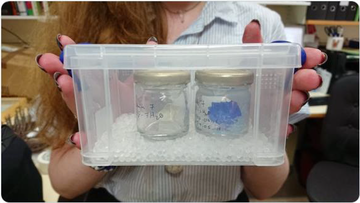
Kathryn holding her samples of deteriorated chalcanthite and melanterite
photographed by Christian Baars
BSc Conservation of Museum Objects & Archaeology
Cardiff University
During my time at Cardiff, I worked primarily on inorganic materials, especially corroded metals. These included copper alloy, tin, and iron objects. I began studying minerals as corrosion products to better understand the object and plan treatments. I also enjoyed using spectroscopic analysis for material identification.
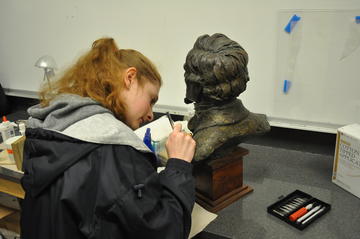
Kathryn removing corrosion products from a copper alloy bust
photographed by Jay Peterson
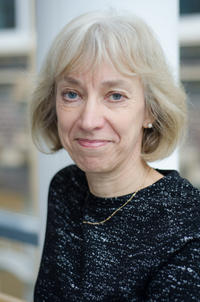
Prof. Heather Viles
Professor of Biogeomorphology and Heritage Conservation
University of Oxford - School of Geography and the Environment
Email: heather.viles@ouce.ox.ac.uk
Twitter: https://twitter.com/Geodiverse
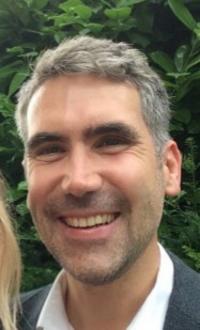
Dr. Christian Baars
Head of Collections Care
National Museums Liverpool
Email: Christian.Baars@liverpoolmuseums.org.uk
Twitter: https://twitter.com/LifeOnBaars
LinkedIn: https://www.linkedin.com/in/dr-christian-baars-ama-acr-8905214/
Research Gate: https://www.researchgate.net/profile/Christian_Baars


